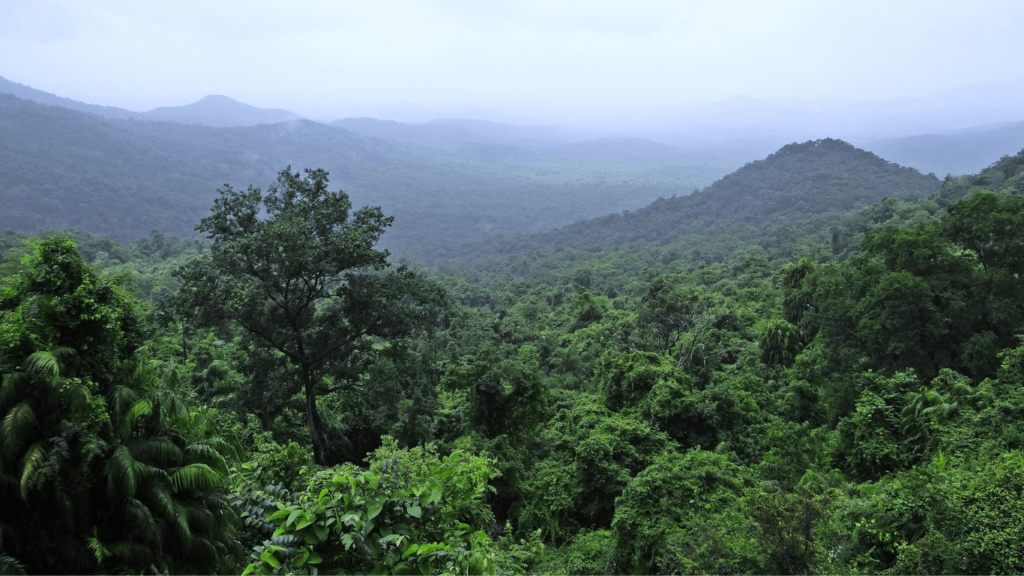Understanding Community-Led Forest Conservation
Community-led forest conservation involves local communities taking active roles in protecting and managing forests. These initiatives draw on local knowledge, ensuring sustainable resource use. Benefits include:
- increased biodiversity
- improved livelihoods
- enhanced environmental resilience
Several factors underpin successful community-led conservation efforts.
Local Participation
Local participation is crucial for community-led forest conservation. Communities engage in decision-making and management processes, aligning conservation goals with local needs. For instance, in Nepal, community forestry programs have seen success through active community involvement.
Traditional Knowledge
Traditional knowledge plays a pivotal role in these initiatives. Communities leverage their understanding of local ecosystems for effective resource management. In the Amazon, indigenous groups use centuries-old practices to maintain forest health and biodiversity.
Economic Incentives
Economic incentives help sustain conservation efforts. When communities see financial benefits from conservation, they are more likely to continue their efforts. In Tanzania, sustainable harvesting projects have provided income while preserving forest resources.
Legal Frameworks
Supportive legal frameworks enhance the effectiveness of community-led conservation. Governments that recognize and protect community land rights enable more successful conservation initiatives. Cases from Mexico highlight how legal recognition of communal lands has bolstered forest management efforts.
Capacity Building
Capacity building empowers communities with the skills and knowledge needed for effective conservation. Training in sustainable practices and resource management helps maintain long-term conservation goals. In India, community training programs have led to significant improvements in forest health.
Monitoring and Evaluation
Regular monitoring and evaluation ensure conservation efforts meet their objectives. Communities track the health of forests and make necessary adjustments. For example, community groups in Indonesia use participatory mapping to monitor deforestation and implement corrective measures.
Key Elements of Successful Community-Led Forest Conservation
Community-led forest conservation relies on several interlinked elements to achieve success. These elements ensure that conservation efforts are effective and sustainable.
Community Engagement
Engaging the local community is crucial for successful conservation. Involving community members in decision-making fosters ownership and responsibility. For instance, in Nepal, local user groups manage community forests, making key decisions about resource use and protection. By participating actively, community members help ensure that conservation measures align with local needs and realities.
Sustainable Practices
Adopting sustainable practices ensures long-term forest health. Techniques like agroforestry, where trees and crops grow together, improve biodiversity and soil quality. In India, the Bishnoi community integrates conservation into their daily lives, using methods like water harvesting and organic farming. These practices not only protect the forest but also provide sustainable livelihoods for the community.
Policy Support
Supportive policies create an enabling environment for community-led conservation. Legal frameworks that recognize community land rights empower local groups to manage their resources effectively. In Mexico, communal land ownership systems, known as ejidos, give communities a vested interest in conserving their forests. Policymaking at regional and national levels should promote community rights and support conservation initiatives.
Funding and Resources
Access to funding and resources is essential for the implementation of conservation projects. Grants and financial support from NGOs, government agencies, and international bodies help communities undertake larger conservation activities. For example, in Kenya, the Green Belt Movement supports reforestation by providing saplings and technical assistance. Adequate funding allows communities to invest in necessary tools, training, and infrastructure.
Success Story 1: The Amazon Rainforest Initiative

Local communities in the Amazon Rainforest have played a critical role in forest conservation through active participation and innovative practices. This section delves into the background, achievements, and challenges of the Amazon Rainforest Initiative.
Background
The Amazon Rainforest Initiative began as a grassroots movement aimed at combating deforestation. Indigenous communities led the effort, leveraging their traditional knowledge and deep connection to the land. The initiative focused on sustainable land management practices that align with conservation goals, such as agroforestry and the use of non-timber forest products. Over time, these practices were formalized into a broader framework supported by various NGOs and governmental policies.
Achievements
- The Amazon Rainforest Initiative has led to significant conservation milestones.
- Indigenous communities successfully protected over 1 million acres of rainforest from illegal logging and deforestation.
- They achieved this through community monitoring programs and ranger patrols.
- The initiative also fostered sustainable economic activities, such as the harvesting of Brazil nuts and medicinal plants, which provided alternative income sources for local families. These activities not only preserved the forest but also improved local livelihoods.
- Collaborative efforts with academic institutions furthered research on biodiversity, highlighting the Amazon’s ecological importance.
Challenges and Solutions
The initiative faced numerous challenges, including illegal deforestation, mining activities, and land tenure disputes. Communities addressed these issues by strengthening local governance and land rights. Legal support was sought to formalize land claims, reducing the threat of external encroachments. To combat illegal activities, they set up monitoring systems using satellite imagery and drones, which improved real-time tracking of deforestation. Capacity-building programs also played a significant role, equipping community members with necessary skills for advocacy and forest stewardship. Overall, the combination of technological tools, legal frameworks, and community engagement provided robust solutions to the challenges faced.
Success Story 2: The Great Green Wall of Africa
The Great Green Wall initiative demonstrates how community-led efforts can combat desertification and improve livelihoods across Africa. This monumental project, supported by local and international partners, aims to create a mosaic of green landscapes across the continent.
Background
Started in 2007, the Great Green Wall initiative spans over 20 African countries from Senegal to Djibouti. The goal is to restore 100 million hectares of degraded land by 2030. Local communities, governments, and international organizations collaborate to plant trees, adopt sustainable farming techniques, and restore ecosystems. This initiative responds to severe land degradation, which affects agricultural productivity and contributes to poverty and migration.
Achievements
The initiative has restored over 18 million hectares of land to date, according to the World Bank. In Senegal, communities have planted more than 11 million trees, helping to stabilize the soil and improve agricultural yields. In Ethiopia, terracing and reforestation efforts have revitalized over 15 million hectares, enabling farmers to grow crops even in adverse climatic conditions. Burkina Faso’s water retention strategies have transformed arid lands into fertile fields, benefiting over 3 million people. These efforts have not only curbed desertification but also boosted local economies, providing jobs and enhancing food security.
Challenges and Solutions
Despite significant progress, the initiative faces challenges like insufficient funding and political instability. Partnerships with organizations like the Global Environment Facility provide financial and technical support, mobilizing resources for local communities. Political instability in regions like the Sahel often disrupts conservation activities, but local governance structures and community resilience strategies ensure continuity. To address water scarcity, initiatives like rainwater harvesting and efficient irrigation techniques have been implemented, securing water sources for both agriculture and daily use. Community training programs emphasize sustainable land management, ensuring long-term success.
The Great Green Wall of Africa exemplifies how community-led initiatives can lead to resilient landscapes and improved livelihoods. Through collaborative efforts, the initiative continues to make strides in transforming degraded lands into green, productive areas.
Success Story 3: The Nepal Community Forestry Program
This section examines the Nepal Community Forestry Program, a pioneering initiative empowering local communities to manage and conserve forest resources. This program has set an exemplary standard for community-led conservation efforts.
Background
The Nepal Community Forestry Program, initiated in the late 1970s, began as a response to widespread deforestation and environmental degradation. The Nepalese government collaborated with local communities to transfer forest management responsibilities to Community Forest User Groups (CFUGs). These groups, legally recognized, received rights to manage forest resources sustainably. This approach leveraged traditional knowledge, ensuring that conservation strategies were tailored to local ecosystems.
Achievements
The program has reaped significant environmental, social, and economic benefits. Over 20,000 CFUGs now manage more than 1.8 million hectares of forest, contributing to a notable increase in forest cover. Biodiversity conservation has improved, with wildlife populations stable or growing in many areas. Economically, the program enhanced livelihoods through sustainable timber and non-timber forest product harvesting, tourism opportunities, and paid forest management roles within the communities.
Challenges and Solutions
The program’s success didn’t come without obstacles. Forest degradation from illegal logging and unsustainable practices posed significant threats. Solutions involved strengthening the legal framework, increasing community awareness, and implementing monitoring systems. Another challenge was ensuring equitable distribution of benefits within communities, addressed by inclusive decision-making processes and capacity-building initiatives. External threats like climate change required adaptive management practices ensuring ecosystems’ resilience.
Lessons Learned and Best Practices
Local participation stands out as a fundamental lesson learned. Allowing communities to have a say in decision-making processes fosters a sense of ownership and accountability. For instance, in the Amazon Rainforest Initiative, Indigenous groups playing a central role empowered them to protect over 1 million acres of rainforest.
Traditional knowledge proves invaluable for resource management. By integrating local customs and knowledge, initiatives benefit from time-tested practices. The Nepal Community Forestry Program demonstrates this, as CFUGs use traditional knowledge to develop tailored conservation strategies.
Economic incentives are crucial. Providing financial benefits to communities helps sustain their conservation efforts. The Green Belt Movement in Kenya illustrates successful engagement through economic empowerment, where financial support enables significant conservation projects.
Supportive legal frameworks enhance community-led initiatives. Recognizing community land rights legally ensures long-term success and stability. Mexico’s ejido system is a prime example, granting legal land rights that bolster community-driven conservation.
Capacity building through training equips communities with vital skills. Ongoing education ensures communities can adopt sustainable practices effectively. Programs offering training in agroforestry, like those seen in the Bishnoi community in India, demonstrate how education can improve both biodiversity and livelihoods.
Monitoring and evaluation remain essential. Regular monitoring allows for timely adjustments, ensuring that conservation goals are met. Technological tools used in the Amazon Rainforest Initiative provide accurate tracking of deforestation, aiding in efficient management and protection strategies.
Collaborative partnerships prove beneficial. Working with NGOs, governments, and international organizations provides additional resources and support. The Great Green Wall initiative’s success in Africa underscores how partnerships help overcome challenges like funding shortfalls and political instability.
Resilience strategies aid in overcoming challenges. Community resilience, shown by their ability to adapt and persist, proves vital in the face of obstacles. Partnerships and local governance in the Amazon Rainforest initiative have addressed illegal deforestation and land tenure disputes, showcasing the importance of strong local governance and legal support.
Access to funding and resources enables significant projects. Financial and material support empowers communities to undertake impactful conservation actions. The success of the Green Belt Movement in Kenya, driven by funding, exemplifies how access to resources is a key driver for large-scale conservation efforts.
The amalgamation of these best practices – from local participation and traditional knowledge to legal frameworks, capacity building, monitoring, collaborative partnerships, resilience strategies, and resource access – showcases the multifaceted approach required for successful community-led forest conservation initiatives.
Future Prospects for Community-Led Forest Conservation
The future of community-led forest conservation looks promising, driven by innovative strategies and increasing global awareness. Technological advancements, such as satellite imagery and drones, provide communities with tools to monitor forests effectively. The ability to track deforestation and wildlife movements in real-time helps prevent illegal activities and ensures sustainable management practices.
Integrating financial mechanisms, like carbon credits and sustainable tourism, offers economic incentives for conservation. By participating in carbon trading markets, communities can generate income from maintaining forest cover, while ecotourism brings financial benefits by attracting visitors interested in conservation efforts. For example, Costa Rica’s ecotourism sector has significantly contributed to both local economies and conservation goals.
Collaborative international projects continue to support community-led efforts. Organizations like the World Wildlife Fund (WWF) and the United Nations Development Programme (UNDP) provide necessary funding and expertise. These partnerships extend the reach of grassroots initiatives, exemplified by the collaboration in the Amazon Rainforest Initiative which has garnered global attention and resources.
Policy evolution at national and international levels is crucial for scaling community-led conservation. Governments can enforce laws that recognize and protect community land rights, enhancing the permanence of conservation areas. Additionally, frameworks like the United Nations’ Sustainable Development Goals (SDGs) influence policy-making, ensuring that conservation remains a priority.
Challenges like climate change and political instability persist, but community resilience and adaptability offer hope. Communities have shown remarkable ability to innovate in response to these challenges. For instance, in regions facing harsher climates, agroforestry techniques integrate trees with crops, improving soil health and resistance to extreme weather events.
Education plays a pivotal role in the continued success of community-led conservation. Training programs enhance skills and knowledge, ensuring that conservation methods evolve with emerging best practices. Providing younger generations with environmental education fosters a culture of conservation and ensures ongoing community engagement.
The combination of advanced technology, economic incentives, international support, robust policy frameworks, resilience, and education sets a strong foundation for the future of community-led forest conservation.



 Mindfulness & Nature Wellness Specialist
Eve Macleod is a certified mindfulness and meditation instructor who has spent years cultivating her passion for connecting wellness practices with the natural world. At Whisper Forest Ways, Eve focuses on guiding readers through techniques that harness the power of nature to promote mental, emotional, and physical well-being. Specializing in forest bathing, nature-based meditation, and eco-therapy, Eve helps readers discover how nature can enhance mindfulness practices and deepen relaxation. She believes that the natural world holds untapped potential for personal healing, stress relief, and spiritual growth, and through her articles and tutorials, she invites everyone to embark on a journey toward a more peaceful and centered life.
Mindfulness & Nature Wellness Specialist
Eve Macleod is a certified mindfulness and meditation instructor who has spent years cultivating her passion for connecting wellness practices with the natural world. At Whisper Forest Ways, Eve focuses on guiding readers through techniques that harness the power of nature to promote mental, emotional, and physical well-being. Specializing in forest bathing, nature-based meditation, and eco-therapy, Eve helps readers discover how nature can enhance mindfulness practices and deepen relaxation. She believes that the natural world holds untapped potential for personal healing, stress relief, and spiritual growth, and through her articles and tutorials, she invites everyone to embark on a journey toward a more peaceful and centered life.
